Bulletin – March 2017 Global Economy The Rise of Chinese Money Market Funds
- Download 1.34MB
Abstract
Money market funds (MMFs) pool funds in an investment vehicle to invest in short-term, highly rated securities. The MMF sector in China has grown rapidly over the past few years and is now the world's second largest by assets, though it is small compared with China's domestic bank deposits. This growth has been driven by investors attracted by high yields relative to bank deposits and technological developments that allow Chinese MMFs to offer a convenient cash management service. Chinese MMFs differ from similar products in many other countries: they tend to be more leveraged, and they offer more liquidity and maturity transformation. Nonetheless, recent regulatory reforms to address vulnerabilities have taken a similar direction to reforms globally.
Introduction
MMFs have become increasingly important to China's financial markets over the past few years. Since January 2013, their combined net asset value (NAV) – the value of a fund's assets minus its debt liabilities – has grown by nearly eight times to around CNY3.6 trillion and the number of MMFs has more than quadrupled to around 295 (Graph 1). By comparison, banking system deposits have only grown by around 1.6 times over the same period. Nonetheless, the value of MMFs' net assets has been broadly stable since late 2015, possibly because investors were shifting into wealth management products (WMPs) in response to the low returns paid on MMFs relative to WMPs.[1]
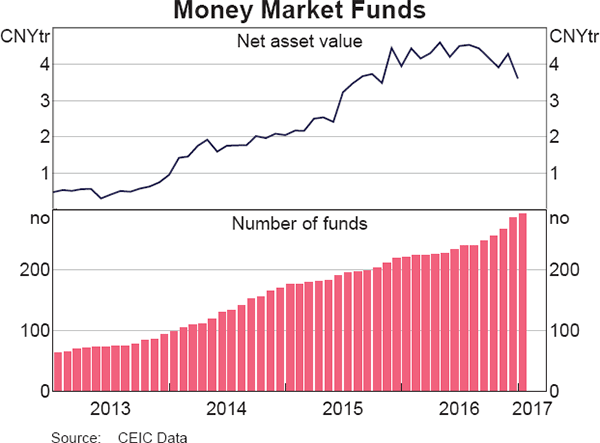
Products marketed as MMFs pool funds in an investment vehicle, with investors in MMFs receiving units (or shares) in this vehicle. MMFs invest largely in short-term, highly rated securities and are generally considered to be low-risk and low-return products with high liquidity. In this regard, MMFs serve as important intermediaries between short-term borrowers (such as governments and corporations that issue highly rated securities) and lenders (retail and institutional investors) who are seeking low-risk and liquid short-term investments.
The emergence of MMFs in China has occurred in the context of the rapid evolution of the broader market for investment products. Other products that have grown rapidly include WMPs, non-MMF mutual funds and products offered by insurance companies and securities firms (Perry and Weltewitz 2015).
This article provides some background on Chinese MMFs before discussing who invests in these funds and potential reasons for their rapid growth. It then outlines MMFs' asset allocations and their importance to Chinese short-term funding markets, before assessing potential vulnerabilities.
The Emergence of Chinese MMFs
Globally, the largest MMF sector by assets is located in the United States, with around US$2.7 trillion in net assets (Graph 2). Chinese MMFs had around CNY3.6 trillion (US$520 billion) in net assets in January 2017, which makes China the second largest market for such funds globally. Total assets held by Chinese MMFs are much larger (US$1.3 trillion) than net assets due to the use of leverage, a practice which is less common or prohibited for these products in many other economies. The rapid growth of MMFs (prior to 2016) has accounted for the majority of growth in the entire Chinese mutual fund sector over the past four years (Graph 3).[2] As a result, MMFs comprise a large share of China's mutual fund sector, in contrast to mutual fund sectors in many other large markets where equity and bond funds typically dominate.
Management of the MMF industry in China is fairly concentrated; the 10 largest asset managers in China account for a little over half of the sector's assets under management (AuM). This concentration is broadly comparable to that in the European Union but substantially lower than in the United States, where the top 10 asset managers hold around 75 per cent of total MMF AuM.
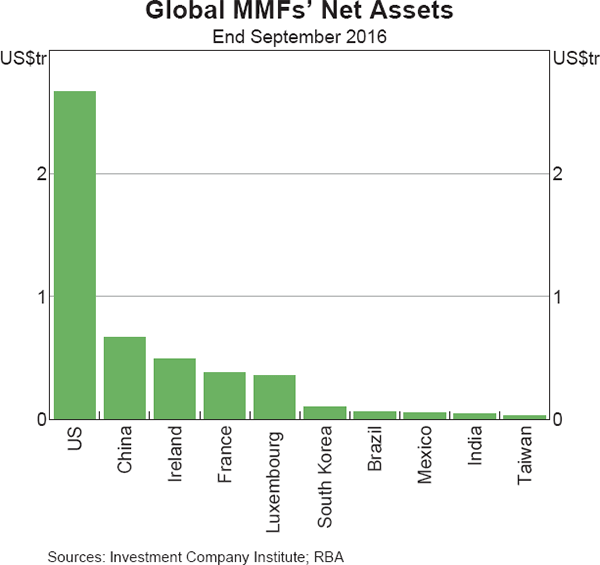
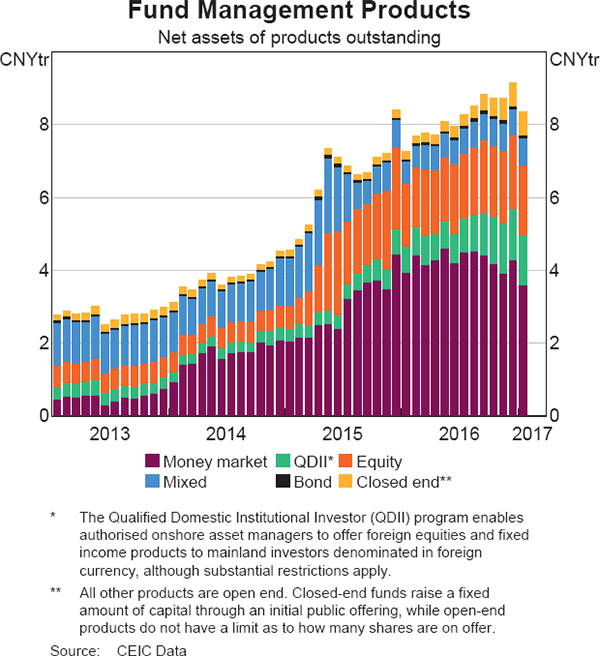
Chinese MMFs compete with WMPs, which also attract short-term funding from retail and institutional investors. WMPs are investments sold by banks and non-bank financial institutions and usually offer fixed rates of return. WMPs typically offer higher returns than MMFs, which reflects WMPs' riskier asset allocation and lower liquidity – funds raised are invested for a fixed term in a range of securities and loans. Nevertheless, like MMFs, WMPs are often perceived to be alternatives to term deposits in China despite carrying more risk. Partly as a result of higher WMP returns, the Chinese MMF sector is much smaller than the WMP sector; MMFs' net assets are around CNY3.6 trillion while banks' WMPs are around CNY29 trillion.
Who Invests in China's MMFs?
Chinese MMFs are an attractive investment option for both retail and institutional investors because many funds provide on-demand redemptions, which make them close substitutes for bank deposits. However, like in the United States, investments in Chinese MMFs are not covered by a deposit insurance scheme, while bank deposits are insured up to predefined limit. Nonetheless, they remain the most comparable investment option for retail investors and are regarded by many investors to be low risk, in part because some of China's MMFs are sponsored or distributed by large corporations and investors expect that these corporations will honour payments if a fund cannot meet redemptions. Indeed, a substantial share of the market is distributed online by financial affiliates of large Chinese technology conglomerates such as Alibaba and Tencent.
Retail investors (rather than institutional investors) dominated inflows into MMFs from 2013 to mid 2015. Through this period, MMFs were able to offer substantially higher returns than those available on retail bank deposits because bank deposit rates were constrained by regulation (Graph 4). In particular, the People's Bank of China (PBC) set deposit rate ceilings at this time (such as the three-month benchmark deposit rate in Graph 4), which were considered to be below market rates.[3] This was similar to the experience of the United States in the 1970s when MMFs were able to avoid a regulation that prohibited the payment of interest on demand deposits at deposit-taking institutions (IMF 2010).
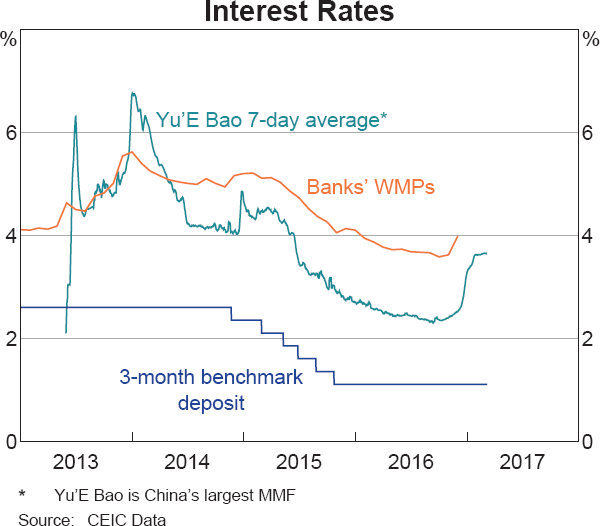
Large MMFs in China had been able to offer higher returns than retail bank deposits because MMFs reinvested their investors' funding into ‘negotiable deposits’ at banks (that is, bank deposits with negotiable maturities and rates). Yields on these negotiable deposits were higher than retail bank deposit rates partly because of the stronger bargaining power of some MMFs compared to individual depositors, and because banks also reinvested these MMFs' funds in higher-risk products. However, over much of 2016, the returns offered by MMFs (such as the Yu'E Bao rate in Graph 4) declined, which may have led investors to shift their investments into alternative financial products, such as WMPs or equities. The rates offered by MMFs have increased more recently, which is likely to have reflected the broad rise in money market rates at the end of 2016, but they still remain below WMP rates.
Strong retail demand for MMFs was also facilitated by the rapid modernisation of the payments system via internet finance platforms, which make MMFs easier to access. These platforms allow MMFs to offer an efficient cash management tool that enables consumers to buy and sell goods online, which has likely contributed to the strong growth of China's largest fund, Yu'E Bao (see: ‘Box A: Yu'E Bao’), and similar products offered by other large, and often non-financial, Chinese corporations and their affiliate entities.
Over the past two years, the investor base of Chinese MMFs has become more similar to that of MMFs in developed markets. Institutional demand for MMF products surged to around half of the overall sector in the six months following the sharp fall in Chinese equity prices in mid 2015.[4] Prior to this, institutional investors held around 30 per cent of all units issued by MMFs.[5] By comparison, in 2012 institutional investors held 65 per cent in the United States, 90 per cent in France, and almost the entire market in Ireland and Luxembourg (IOSCO 2012).
One structural difference between Chinese and developed market MMFs, however, is how extensively leverage is used. Chinese MMFs have been able to increase the scale of their investments (and returns) by using debt funding; investors' funds only comprise around half of MMFs' funding (Graph 5).[6] This is in contrast to MMFs in developed markets, where leverage is either prohibited (such as in the United States) or strictly limited (such as in the European Union, where leverage is limited to 10 per cent of assets). Chinese MMFs use repurchase agreements (repos) to obtain leverage and achieve a higher yield. Market sources suggest that most repo activity by Chinese MMFs occurs in the interbank market – that is, Chinese MMFs borrow from financial institutions such as banks whereas MMFs in other countries would typically act as lenders in repo markets.
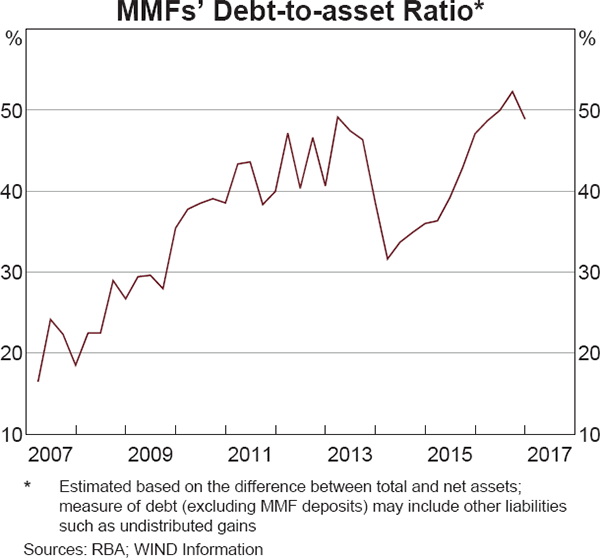
MMFs, however, comprise only a small share of the repo market. MMFs and other types of funds in China (referred to locally as ‘funds institutions’) borrow only CNY4.2 trillion and lend CNY2.7 trillion of the CNY31 trillion interbank repo market (Graph 6). National commercial banks dominate this market, although WMPs (many of which are off-balance sheet vehicles of banks) have also become important sources of funding.
Box A
Yu'E Bao
- Yu'E Bao is the largest MMF in China and one of the largest in the world with around CNY800 billion (US$120 billion) in total assets at end September 2016.
- The fund is offered through Alipay, an affiliate of e-commerce firm Alibaba, and is managed by Tian Hong Asset Management through its Tian Hong Zeng Li Bao fund.
- It was established in mid 2013, and has more than 250 million retail investors; more investors than China's equity markets. Investors include individuals and corporations (e.g. sellers on Alibaba's online commerce platform Tao Bao), most of which are reportedly looking for investments of less than three months.
- Investors buy units in Yu'E Bao by transferring funds (with a minimum of only CNY1) from a linked deposit account to their Alipay account through the Alipay app; investors can draw on multiple bank cards (or receive payments from other individuals' Alipay accounts) to purchase units in Yu'E Bao. But, banks limit the amount their customers can transfer to Yu'E Bao per day per card and can vary this amount.
- Yu'E Bao operates 24 hours a day and allows online shopping purchases from MMF dividends, offering clients an efficient cash management facility.
- Little information on the underlying investments is available to investors; the fund's broad asset allocation is available on the website and is updated on a quarterly basis.
- Investors can withdraw funds from Yu'E Bao at any time and there are no limits on the amount that can be withdrawn; however, since October 2016 Yu'E Bao has imposed transfer fees on users transferring more than CNY20,000 to a third party. There are also potential delays for larger withdrawals: for example, there is a two-hour delay for withdrawals of up to CNY50,000 and up to a 48-hour delay for larger withdrawals (timeframes also vary depending on the bank to which money is being transferred). Investors can make up to three withdrawals per day.
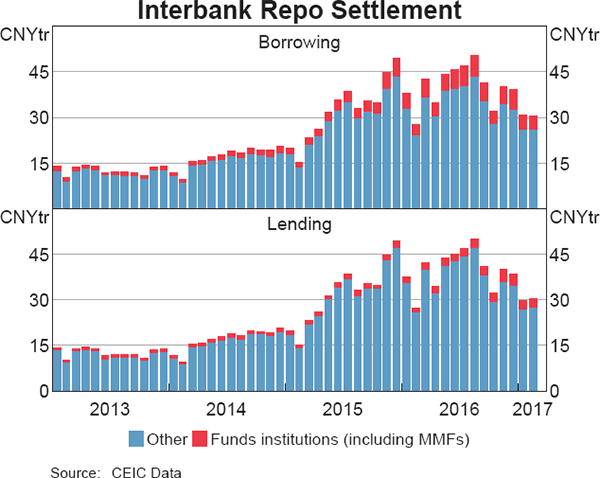
Chinese MMFs' Assets and Their Role in Funding Markets
Chinese MMFs invest in three broad asset classes: cash equivalents; fixed income securities; and other investments (Graph 7).[7]
- Cash equivalents are predominantly negotiable deposits at banks. Since investors are likely to have switched to MMFs from bank deposits, the growth of MMFs is likely to have increased the cost of banks' deposit funding. It has, however, allowed banks to increase lending to some extent because unlike retail deposits, negotiable deposits are exempt from China's high reserve requirement ratios.
- MMFs' fixed income investments include Chinese government paper, policy bank paper, some short-term commercial paper and, more recently, certificates of deposit with banks.[8],[9]
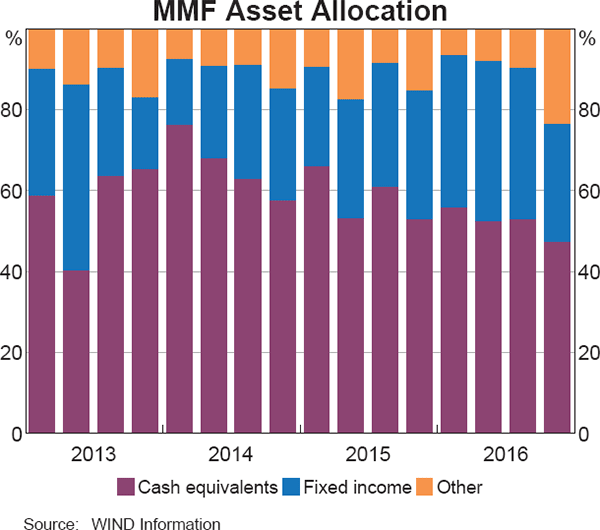
- The ‘other’ category includes loans, reverse repos (which is when MMFs lend money, including to other mutual funds) and investments in WMPs, but the exact composition of this category is unclear.
Cash equivalents and fixed income securities account for around 75 per cent of aggregate MMF AuM, but asset allocations can vary widely between funds. In terms of the quality of the securities in which they invest, Chinese MMFs are restricted to investing in commercial paper rated AA+ or higher by a local credit rating agency. This is notionally higher than in the United States where investments can be rated A, but Chinese ratings are not directly comparable to those assigned by international ratings agencies. Chinese regulations also permit investments in corporate paper with longer maturities than in the United States.
Available data do not reveal how much corporations, banks and governments depend on funding from Chinese MMFs. In the United States, MMFs are significant providers of funding; prime MMFs hold around 8 per cent of the commercial paper market and 2 per cent of US Treasury bills. For China, limited data suggest that non-bank financial corporations (which include MMFs) hold around 30 per cent of commercial paper and around 25 per cent of policy bank bonds, which makes them significant funders of these sectors.[10] However, there is no breakdown of the financial entities providing these funds. Corporations in China are also generally more reliant on bank funding than corporations in the United States.
MMFs also provide funding to other financial institutions by lending via reverse repo in the smaller exchange-traded markets in Shanghai and Shenzhen rather than in the much larger over-the-counter interbank market. This is largely because counterparty risk is lower when stock exchanges centrally clear all repos. While data on turnover in the exchange-traded markets are not readily available, market sources indicate that a key recipient of these funds are non-MMF mutual funds, which borrow to purchase more assets and to fund redemptions from their investors. Nonetheless, the stock exchanges have typically only accounted for 5–10 per cent of total repo market activity.
Assessment of Vulnerabilities
One concern about MMFs is that they can amplify stressed conditions in financial markets. A large share of investors withdrawing funding from MMFs can harm the functioning of money markets and lead to pressure on banks' funding; this happened to US and European MMFs during the global financial crisis (IOSCO 2012). Chinese MMFs are subject to less restrictive regulations compared to their counterparts in developed economies, and may in principle be more vulnerable to these sorts of risks. Features of MMFs that can contribute to the propagation of financial stress include:
- maturity and liquidity mismatches. A maturity mismatch refers to the difference between the term of MMFs' assets and liabilities, and a liquidity mismatch refers to the difference between the length of time it takes investors to redeem funds from MMFs and the (longer) length of time it can take MMFs to sell assets to fund these redemptions. These mismatches can lead to fire sales and exacerbate price falls in other financial markets if MMFs are required to meet large redemptions;
- the use of leverage, which can exacerbate maturity and liquidity mismatches as MMFs that cannot roll over their debt funding may need to quickly unwind positions (including funding to banks). Leverage also exacerbates any MMF losses; and
- constant NAV. If an MMF's liabilities (including those to unit holders) exceed the market value of its assets, the MMF may ‘break the buck’ – that is, reduce the value of its units to below par – in the event of significant redemption requests from unit holders. The prospect of such an event may induce a run on the MMF sector more broadly, as occurred in the United States in 2008.
As a result of the global financial crisis, international organisations and national regulators have developed reforms that aim to improve the risk management frameworks of MMFs, with a focus on mitigating their susceptibility to heavy redemptions (IOSCO 2015). The China Securities Regulatory Commission has introduced rules that came into effect from February 2016, which bring China's regulatory framework closer to these international standards. However, even under these new rules, MMFs in China still exhibit some important structural differences to their counterparts in large developed financial markets (Table 1). For example, Chinese MMFs are able to obtain leverage of up to 20 per cent (revised down from 40 per cent, although available data imply that departures from this limit have occurred), compared with 10 per cent in the European Union and zero in the United States. Chinese MMFs can also undertake more maturity transformation; Chinese MMFs are allowed to hold assets with a maximum weighted average maturity of 120 days, twice that allowed in the United States. These differences could result in greater risk-taking by Chinese MMFs, but the level of risk is difficult to compare across countries as MMFs are affected by numerous factors, including broader differences in the financial systems in which they operate. For instance, recent US MMF reforms require prime funds to trade on the basis of a variable NAV, which allows an MMF's unit price to more closely reflect movements in the market value of its assets over time. This limits the focus on the point at which the fund ‘breaks the buck’. The reforms also allow prime MMFs to temporarily freeze redemptions if necessary.
| China | United States | |
|---|---|---|
| Maximum weighted-average maturity | 120 days (previously 180 days) | 60 days |
| Liquidity | Minimum 5% in cash, Chinese government bonds, PBC bills and policy bank bonds, 10% of the above assets must mature within 5 days, and no more than 30% of non-tradeable portfolio with more than 10-day maturity (previously no liquidity requirements were specified)(a) | Minimum 10% of portfolio overnight maturity and 25% within 7 days |
| Redemption | Same day retail; day after institutional | Same day |
| Diversification | Maximum of 10% of commercial paper from single issuer | Maximum of 5% of commercial paper from single issuer |
| Leverage | Maximum 20% (previous maximum 40%) | Prohibited |
|
(a) Non-tradeable assets include: bank term deposits (though, contractually many funds have negotiated for before end-term redemption for no financial consequence – deposits of this type are therefore exempt from this rule) and reverse repo with more than a 10-day maturity Sources: China Securities Regulatory Commission; Fitch Ratings; Goldman Sachs; Securities and Exchange Commission |
||
While Chinese MMFs appear more leveraged and have larger maturity mismatches than their US counterparts, their assets are small relative to the size of the banking system. Chinese MMFs also have provisions that help mitigate some of these risks. Redemption freezes can be imposed if they face redemptions of 10 per cent or more for two consecutive days and some funds have also negotiated contracts with banks that allow them to break term deposits without penalty (albeit possibly at the cost of tighter liquidity for banks). MMFs also sometimes benefit from periods of broader financial market stress as investors shift from higher-risk products (such as equities) into MMFs.
Conclusion
The Chinese MMF sector has grown significantly over the past few years to become one of the largest MMF sectors in the world. That growth partly reflects the attraction of higher returns on MMFs than on bank deposits and easier access through technological innovation. To the extent that MMFs experience further rapid growth, they are likely to play an increasingly important role in China's financial markets.
While MMFs are not as risky as other investment products such as WMPs, Chinese MMFs exhibit structural differences to MMFs in many other jurisdictions, such as their use of leverage and generally longer average maturities of their assets. The recent implementation of regulations by the Chinese authorities has reduced these differences, although the regulatory framework still permits a greater degree of risk-taking by Chinese MMFs. The vulnerabilities apparent in the Chinese market increase the chances of substantial redemptions from Chinese MMFs, which could adversely affect other parts of the financial system if the role of MMFs grows in the future.
Footnotes
The authors are from Economic Group and International Department, respectively. [*]
WMPs are investment products sold by banks and non-bank financial institutions that usually offer fixed rates of return. WMPs generally have higher-risk asset allocations than MMFs and lower liquidity. [1]
The mutual fund sector includes bond and equity funds, in addition to MMFs. [2]
The ceilings on deposit rates were removed in October 2015, although deposit rates in China are still thought to be largely tied to the PBC's benchmark rates. [3]
For further detail on the movements in Chinese equity markets, see RBA (2015a, 2015b). [4]
This level of retail participation is similar to the Chinese stock market. [5]
MMFs' leverage is estimated as the difference between total assets and net assets (net assets are equivalent to the ‘equity’ in MMFs). [6]
More granular data on MMF investments in China are not readily available. The breakdowns within these categories in this article are sourced from IOSCO (2015) and various market reports. [7]
China has three ‘policy’ banks that are responsible for government-funded spending and targeted lending. [8]
Authorities announced new guidelines for certificates of deposit in mid 2015, which partially liberalised these products. [9]
Bonds account for a significant share of policy banks' funding. [10]
References
IMF (International Monetary Fund) (2010), Global Financial Stability Report: Sovereigns, Funding, and Systematic Liquidity, World Economic and Financial Surveys, IMF, Washington DC.
IOSCO (International Organization of Securities Commissions) (2012), ‘Money Market Fund Systemic Risk Analysis and Reform Options’, Consultation Report, April.
IOSCO (2015), ‘Peer Review of Regulation of Money Market Funds’, Final Report, September.
Perry E and F Weltewitz (2015), ‘Wealth Management Products in China’, RBA Bulletin, June, pp 59–67.
RBA (Reserve Bank of Australia) (2015b), ‘Box A: The Recent Decline in Chinese Equity Prices’, Statement on Monetary Policy, August, pp 28–29.
RBA (2015a), ‘Box B: Recent Developments in Chinese Equity Prices’, Statement on Monetary Policy, May, pp 32–33.